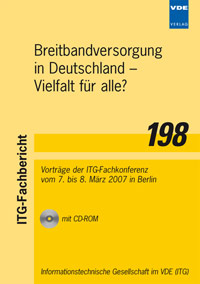Can the increased bandwidth demand be covered with a copper infrastructure or shall fibre meet this demand?
Conference: Breitbandversorgung in Deutschland - Vielfalt für alle? - ITG-Fachkonferenz
03/07/2007 - 03/08/2007 at Berlin, Germany
Proceedings: Breitbandversorgung in Deutschland - Vielfalt für alle?
Pages: 6Language: englishTyp: PDF
Personal VDE Members are entitled to a 10% discount on this title
Authors:
Bedö, Gerlinde (Siemens Networks FN, Rudolf-Vogel Bogen 5, 81730 München)
Abstract:
Today’s deployed access networks are mostly copper based and DSL (ADSL) is the broadband connectivity. New services and applications like video, storage and community services are driving bandwidth demand beyond ADSL capacity in both directions downstream and upstream. Latest DSL developments like VDSL(2) already fulfil these demands: up to 50 Mbit/s can be offered to the subscriber. However, these high bandwidths require some changes in the existing access network: the DSLAM has to be closer to the subscriber, leading to a FTTC (Fibre to the curb) architecture. The closer the DSLAM to the subscriber, the higher is the possible bandwidth. Highest bandwidths can be achieved with a FTTB / FTTH (Fibre to the building / Fibre to the home) architecture. But DSL is not the only technology for broadband access networks: GPON and Ethernet are the FTTB/H alternatives. In future, FTTB/H will be THE architecture as no more economically interesting standard for higher bandwidth over copper cable is expected after VDSL2.


